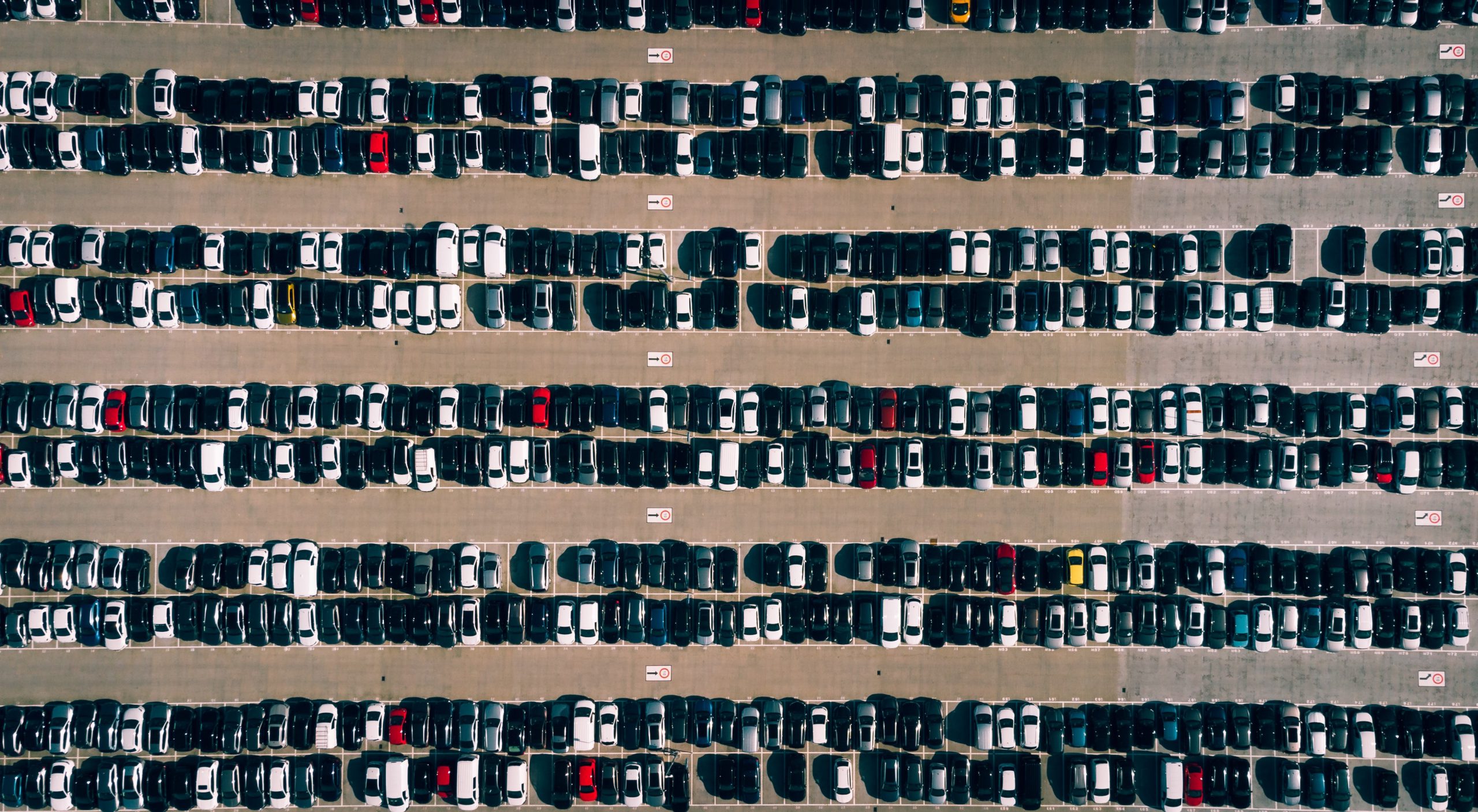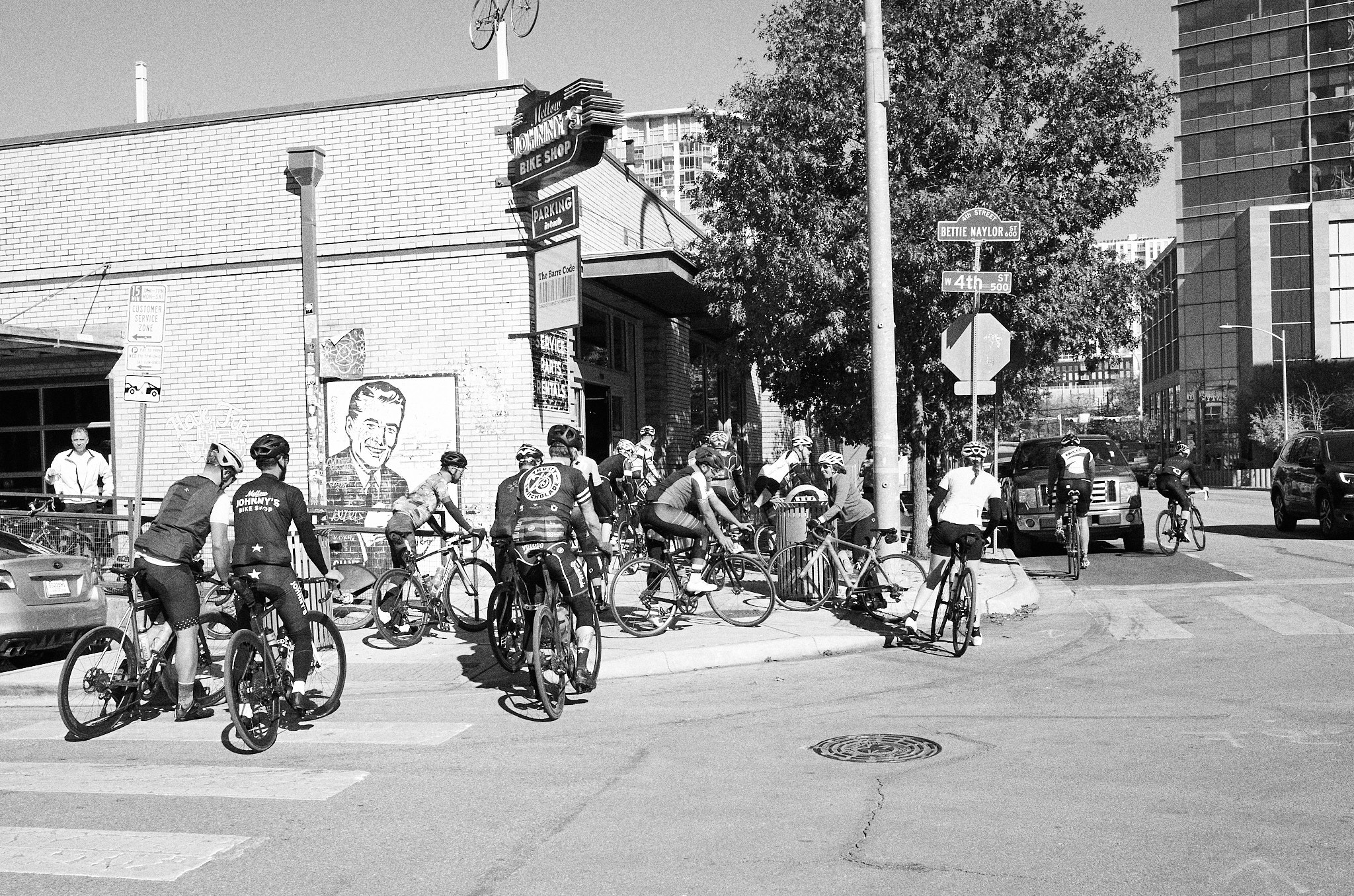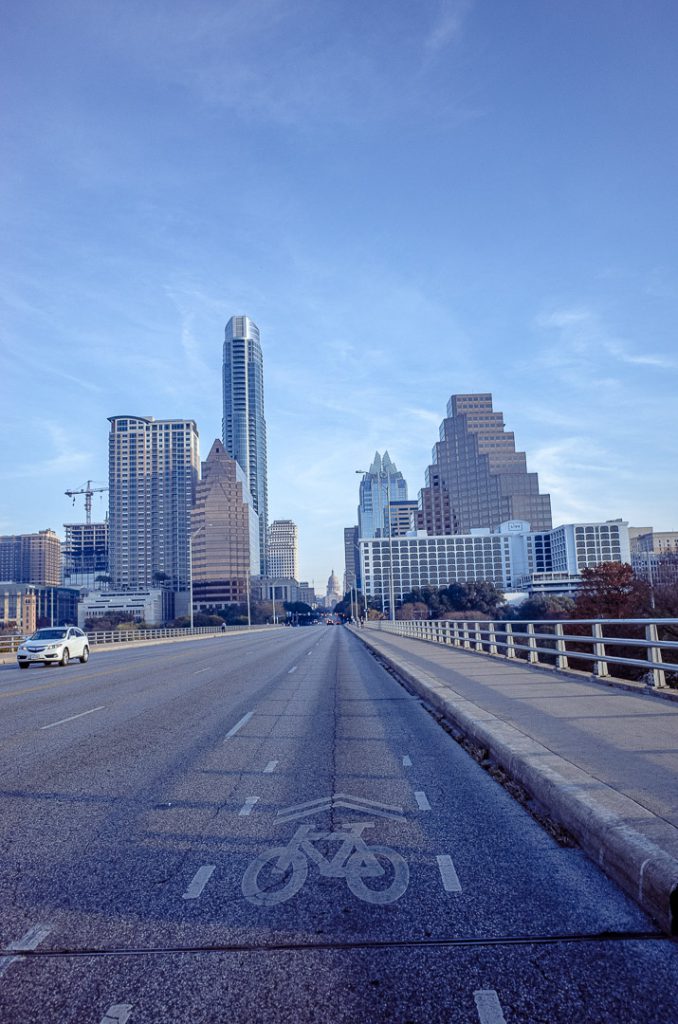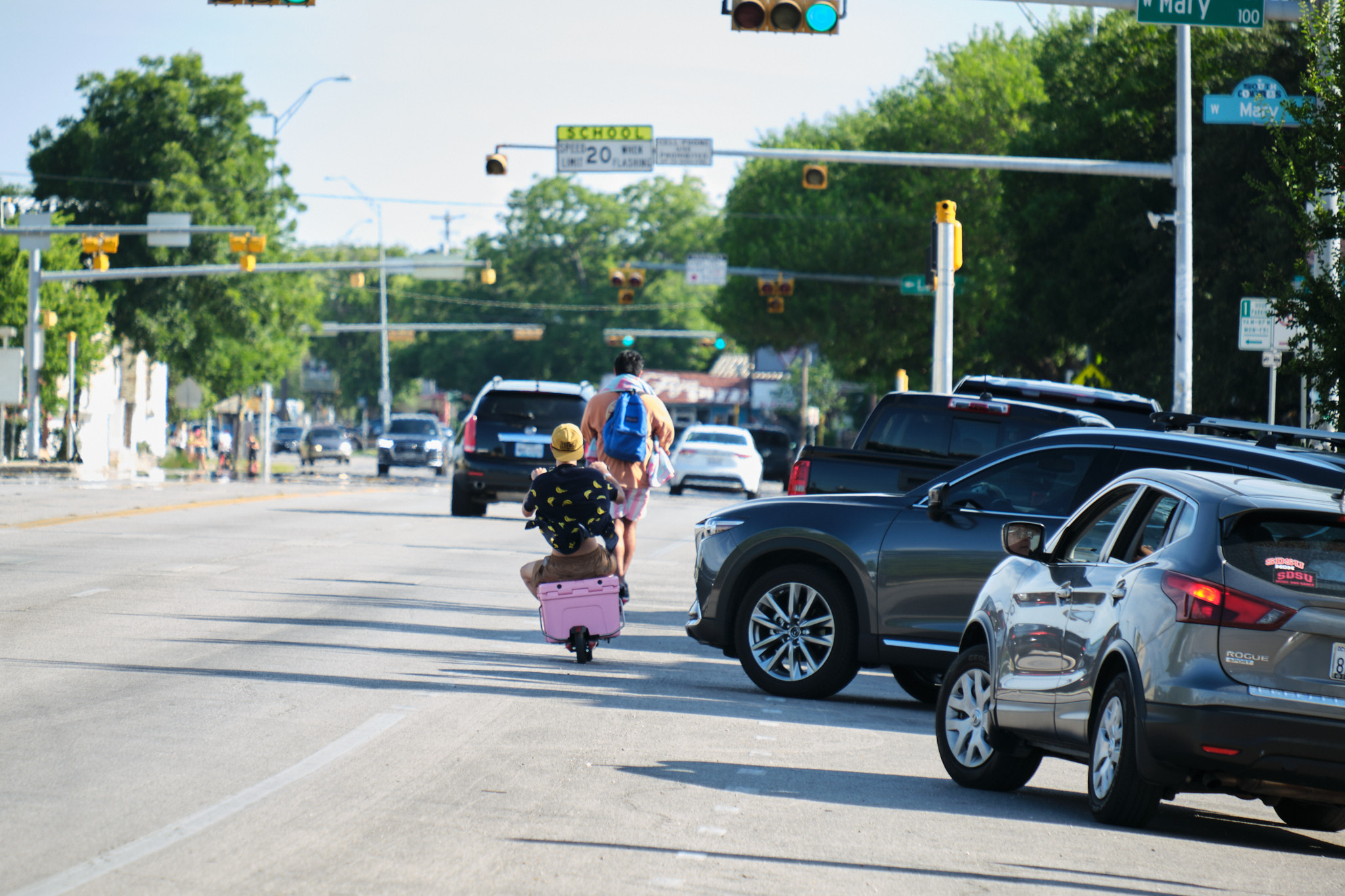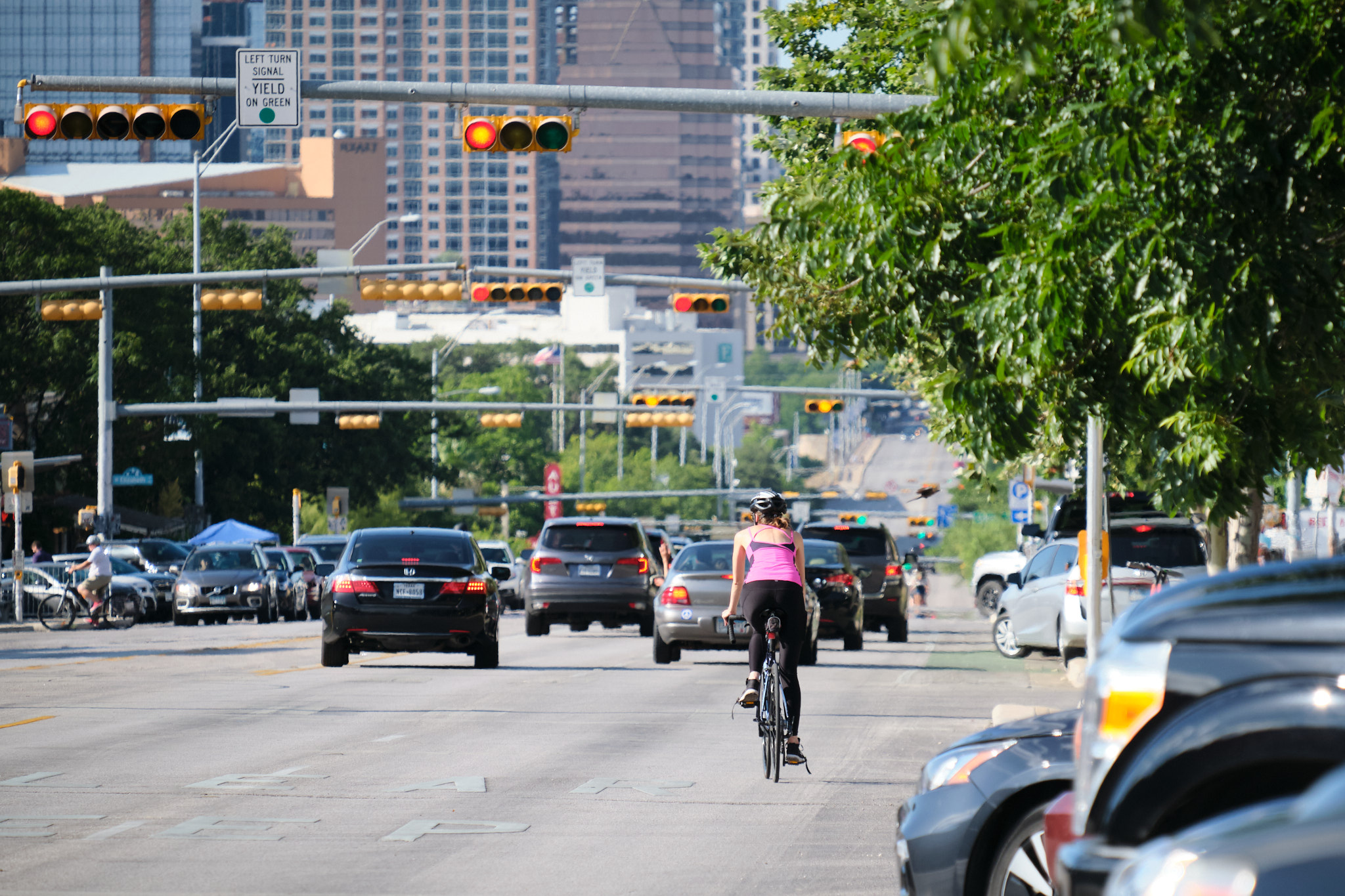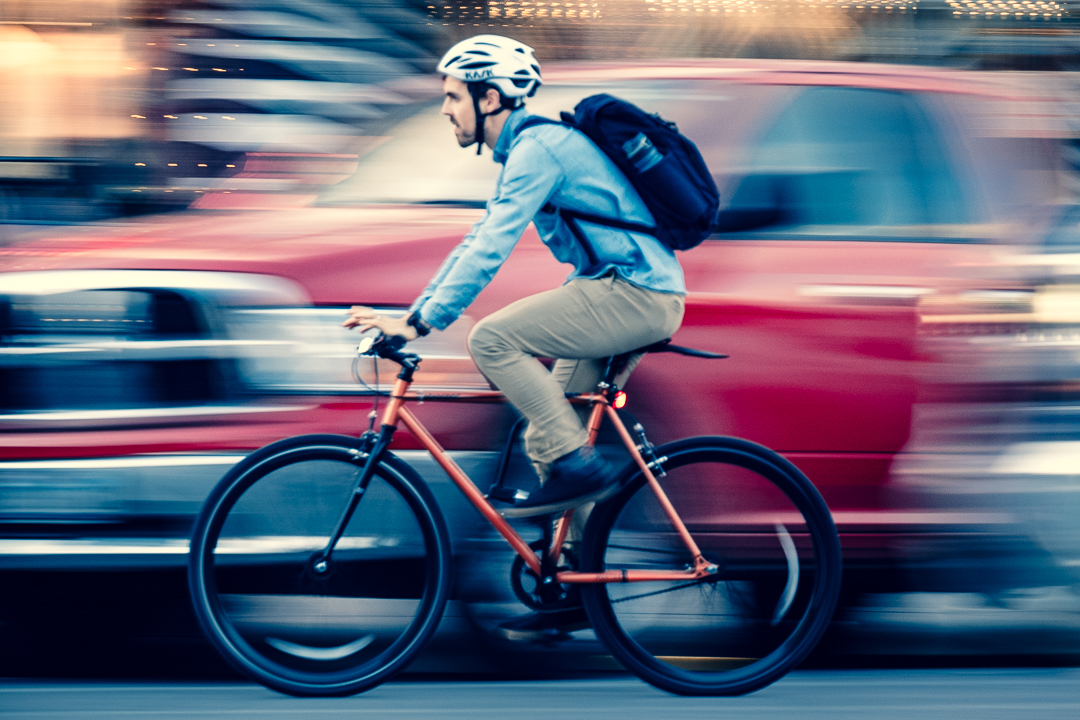I Bought a Car and Feel Terrible About It
If I'm honest with myself, embarrassment deserves partial credit when considering the reasons that I first sold my car. In my defense, values about transportation and housing policy were ultimately the deciding factor. For the previous two-ish years, I had been getting around Austin primarily by bike. The car simply sat there, accumulating maintenance and insurance expense that could be spread to various other modes of transportation.
When I finally worked up the guts to get rid of my "friend," as I thought of it — a beat-up (very) but reliable 2005 Honda Accord —it was a quick breakup. A scammy guy showed up within two hours of my long-winded Craigslist ad going live (that I'm sure he didn't even appreciate), and convinced me to let him drive away with an open title (a practice my naïveté left me unaware of at the time). Aside from worrying if my now unregistered vehicle would be used to rob a bank, I was finally free from the burdens of car ownership.
Transportation then became a multi-modal buffet of bikes, busses, trains, Ubers and rental cars. This method wasn't necessarily cheaper but seemed to offer a certain kind of freedom, in addition to allowing me to pay upfront for transportation expense rather than hiding it away in creeping depreciation, future auto maintenance bills and bi-annual insurance payments. For the most part, travel was either an enjoyable experience ("the journey is the destination" by bike, after all), or a stress-free trip handled by someone else (Uber, bus, train). Things were working out swimmingly, then Covid happened.
As of this writing, the virus is only just beginning to wane. It's still too recent for me to understand just how I'll look back on it, but I suppose it might be thought of as something like "the time when everything stopped". With businesses closed and not many people moving around, many of my mobility options dried up. Sure, the bike was always there, but bus service slowed to an unusable crawl and the many scooter and e-bike shares around Austin were removed, allegedly to stop the spread, though probably for liability reasons (let's not pretend these companies care about your safety).

The feeling of isolation so many have written about over the past year set in, and I found myself wanting to "escape" or "get out of here". Escape what? At the time, I wasn't sure, but it seemed like a car was the way to do it. Looking back, the thing I wanted to escape was my own head, and pouring over AutoTrader and the minute details of different vehicles was my outlet. This behavior has occurred enough times in my life that I can recognize it, but only after the fact. When in the grips of this escapism, the thoughts seem entirely rational.
Over a month of looking finally revealed the type of vehicle I wanted: Something reliable, technologically simple (older) and ordinary (I know, aren't I exciting?). The winner was a 2011 Toyota RAV4 for sale an hour away in San Antonio.
Finally, a car. I was "free”, or so I thought for a day or two. Even with a car, it was soon revealed that there was still nowhere to go and, now, in addition to the cost of the car, I had $800 in taxes to pay, $700 for annual insurance and a $400 maintenance bill. These expenses, plus the down payment, covered what would have previously been an entire year's worth of transportation expense. I fell for my irrational purchase escapism and paid the price.
Sure, having a car is convenient, but by living without one in a city like Austin, you quickly realize that the drawbacks are overcome relatively easily. Even considering the gross lengths we go to as a society to make driving as easy as possible, one can get around reasonably simply with a bit of planning and slightly more effort if the location of one's housing is wisely selected. With this in mind, every trip in my new ball-and-chain is marred with the knowledge that "an e-bike would have been perfect for this" or "a ten-minute wait would have allowed me to make this trip by bus", each alternative scenario costing hundreds or thousands of dollars less in the long run.
In the first month of ownership, I tried to sell the car, and even found a potential buyer. However, the reality of my sunk costs was undeniable: The price of keeping it was lower than selling and returning to my previous modes of transportation, making the sale a purely ideological decision. Ultimately, I chose conformity and convenience over values.
Does the car have its benefits? Sure. I sometimes see it as the ultimate cycling accessory. I can travel to any event or perhaps a far-away ride without consideration of how I'm going to get there. In the past, this was usually via rental cars, which aren’t always available. With a new gravel bike, I can drive out to the countryside and start new routes in spots I would previously have had to ride for a couple of hours to reach. This summer, I'll drive nine hours to participate in Unbound (formerly Dirty Kanza) and maybe also do some riding in West Texas. These decisions are made all the easier when transportation planning requires little more than a stop for gas.
At the same time, these drives are a reminder that the prevalence of the automobile is the reason it takes so long to reach anything that resembles the countryside. Between home and nature are miles of highways and sprawl, full of gas stations, big box stores and McMansions. Some places in the world manage to keep their cities dense enough that a short train trip or bike ride is enough to reach more rural settings and, once there, communities that are more accepting of cyclists. This is far from the reality of life in Texas.
Some places in the world manage to keep their cities relatively dense, allowing rural settings to be reached quickly by train or bike. These places also seem to be more accepting of cyclists. Sure, my small hometown has plenty of countryside, but I’ve probably been honked at there more times than I have in Austin.
So, was it worth it? No. For me, the costs and responsibility of car ownership outweigh its benefits. The "lost year" is coming to an end and with it a return to the normalcy of my previous transportation options. I write you from a bike shop where I've just picked up a bike from a tune up. In the past, I would have taken a scooter here and ridden the bike back — to me, a more gratifying and fun way to travel than firing up my 4,000 pound cage.
Welcome to Austin, New Cyclist
Before COVID, Austin was an outstanding place to be. Wonderful bars and restaurants, great ways to experience nature, and a plethora of events every day of the week - all taking place in year-round nice weather (though sometimes a bit hot).
One more feather in Austin’s cap, and a big reason I continue to live here, is the city’s great cycling community. Austin is full of commuters, road cyclists, casual trail jaunt-ers anything in between (including some pretty awesome pedicab services). As with everything else, most cycling-related events have been cancelled this year, however, one thing that isn’t cancelled is enjoying the outdoors, which many have chosen to do by bike over the past several months. Nay, Covid has caused a bit of a national bike boom, with demand so high that many shops are repeatedly selling out of new stock, and maintenance services are backed up for weeks.
With so many new cyclists on the road, it’s a shame we can’t welcome them in the usual fashion. Someday, though, normalcy will return and, with it, all the things that make riding bikes in Austin great. You, new cyclist, should be ready when that day comes, so here’s an over of some of the more prominent contributors to the Austin cycling community.
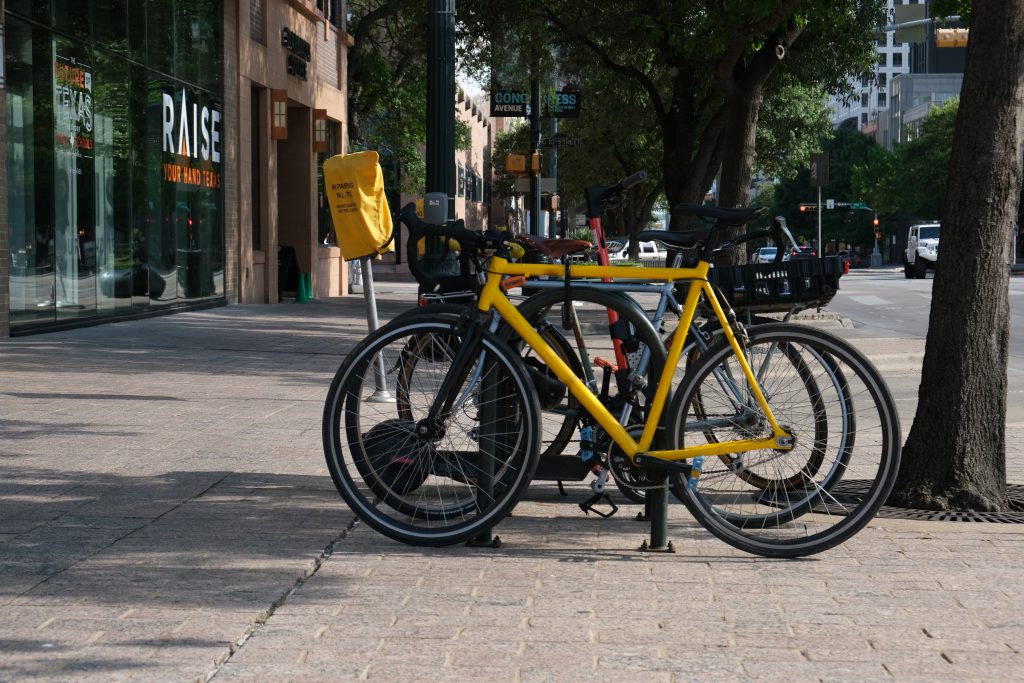
Organizations
Social Cycling Austin
Start here. Seriously. Social Cycling Austin is a FB group of over 12,000 members representing every possible cycling niche. The group is an amazing place to ask questions, find people to ride with, learn about Austin cycling, in general, and is also the home of the famous Thursday Night Social Ride, which has become an institution in the community. Think of SSA as your all-purpose, one-stop-shop for general cycling info in Austin.
https://www.facebook.com/groups/socialcyclingaustin
Bike Austin
It’s good to be a member of Bike Austin. This is an advocacy group that works closely with city government on bicycle issues - most importantly, safety. Bike Austin hosts rides, garners support for city projects and gives back to cyclists in the community. During COVID, the organization helped build support for Healthy Streets to allow pedestrians and cyclists to enjoy socially-distanced recreation without having to worry about automobile traffic. The more cyclists we can get behind Bike Austin the better.
Ghisallo Cycling Initiative
Ghisallo provides bike-related educational programs to Austin’s youth with the aim of creating lifelong cyclists, and also normalizing the use of bikes for transportation. The group conducts clinics focused on safe riding as well as numerous bicycle maintenance programs. If you’re a parent who wants to bring some cycling education to your child’s school, Ghisallo is a great place to start.
Violet Crown
Violet Crown is the oldest and largest cycling club in Austin, and they have the old newsletters and photos to prove it.If want to hear stories about Lance and the old Tuesday Nighter, Violet Crown is your jam. This organization facilitates numerous weekly group rides, and you’ll likely see riders sporting VC kit at other group rides as well. If you’re getting more serious about cycling and want to ride with faster groups or are considering racing, Violet Crown is a great place to get started.
Yellow Bike Project
Ya know all those micro-mobility scooters and bikes you see sitting all over the city? Well, Austin’s Yellow Bike Project was an early adopter in this area. In 1997, they repaired hundreds of bikes, painted them yellow and put them on the street for Austinites to use for their daily transportation needs, for free! Unfortunately, human nature got in the way and the project eventually fizzled out. Still, the organization remains and is an outstanding resource for purchasing reasonably priced bikes in Austin, as well as learning to repair your own bike. YBP is a community bike shop, offering classes, open community shops and even an earn-a-bike program, in which you can earn a free bike in exchange for volunteer hours. I highly recommend you visit the shop to see what it’s all about.
Coffee Outside ATX
#CoffeeOutside is a national community of cyclists who meet up for, well, coffee outside, and #CoffeeOutsideATX is Austin’s iteration of the group. Multiple different meeting places are used that showcase the city’s many outstanding parks. This is a small gathering, but a fun thing to do and good way to meet people if you’re new to Austin.
https://www.instagram.com/explore/tags/coffeeoutsideatx/
Bike Shops
Austin is chock full of bike shops. You’ll have no problem finding the one that fits your vibe. And though I hate to exclude any, as I’m thankful for all bike shops (even the bad ones), I’ll briefly include here those with which I have direct experience:
Mellow Johnny’s
Mentioned first because it’s the most famous shop in Austin. Mellow Johnny’s, so named because it sounds like the french maillot jaunt (yellow jersey), is owned by Lance Armstrong and is full of classic Tour de France bikes and other memorabilia. The cycling artifacts, in addition to it being a great shop, make photo-taking out-of-town visitors a common sight in the store. Is MJ’s a great shop for the casual cyclist? Sure, they’re friendly and have some nice hybrid/commuter bikes. Still, I perceive MJ’s to be more geared toward the serious racing cyclist. They carry a lot of high end stuff and prices can be shocking, especially if you’re simply interested in cruising the hike ’n bike trail.
https://austin.mellowjohnnys.com/
Cycleast
To me, Cycleast is the “hipster” shop. They have an amazing coffee shop on location and many of the bikes you see being sold or parked outside are of the steel (and sometimes single-speed) variety. But don’t be fooled, this shop hosts some amazing competitive riders and is also the home of Austin’s Phenom Cycle Club - a popular group in the racing community that holds the weekly Phenom 50 ride. I prefer to have my commuter serviced at Cycleast because they’re down-to-earth and reasonably priced (and within biking distance of my home).
Bicycle Sport Shop
I spend significantly more time at Mellow Johnny’s due to their co-located coffee shop, however, Bicycle Sport Shop is still my favorite shop in Austin, namely the South Lamar location. They’re huge and nationally known, with five locations in Austin, yet still manage to to feel welcoming and familiar. The owner, Hill Abel, is also an outspoken cycling advocate, which I appreciate. BSS caters to everyone, and is both an outstanding place to buy your first “real” bike, or your 10th high-end carbon race bike. Of all the shops in Austin, I’d say Bicycle Sport Shop appeals to the widest clientele.
Bike Farm
Let us not forget Bike Farm, a small shop slightly further away from my usual bubble of existence, but worth the trip nonetheless. Bike Farm carries brands that the other shops don’t, many of which are more reasonably priced. They also have a huge used a new-old-stock selection, which can be browsed online from the safety of your standing treadmill desk. Literature aficionados will also appreciate the titles on their service menu.
Other Events and Resources
CapMetro
Did you know that you can bring your bike on the bus? It’s true! Capital MetroRail also invites riders to bring their bikes. If you’re a commuter who lives a little further away and wants to use their bike for “last mile” purposes, CapMetro is a great way to do it. More transit centers are popping up around Austin and I can tell you from experience that it’s entirely possible to get around multi modally without driving.
https://www.capmetro.org/bikerack
Driveway Series
Even serious roadies who don't live in Austin know about The Driveway Series. It's arguably the best weekly criterium series in the country, and also a just a fun place to be. On Thursday evenings, you might see speed suit adorned riders making their way to the east side of town for the weekly race or returning at twilight for tacos and beer a La Mancha Tex Mex Tavern. Driveway is a culture and, in my opinion, one of the coolest thing about Austin. Here's an intense promo video from their site:
CotA Bike Night (is awesome)
Circuit of the Americas in an Austin landmark, and the only purpose built Formula One track in the United States. Its scale is hard to appreciate from afar, so why not see it up close? CotA Bike Night, held every Tuesday throughout the summer is fun way to ride without having to worry about traffic in a truly interesting environment. All kinds of riders are welcome. You’ll see teams doing workouts, families with kids, e-bikes and everything in between. Worried about climbing the 11% grade before turn 1? No problem. There’s a bypass to skip that portion of the track, but I recommend you take on the challenge at least once. Check out the view:
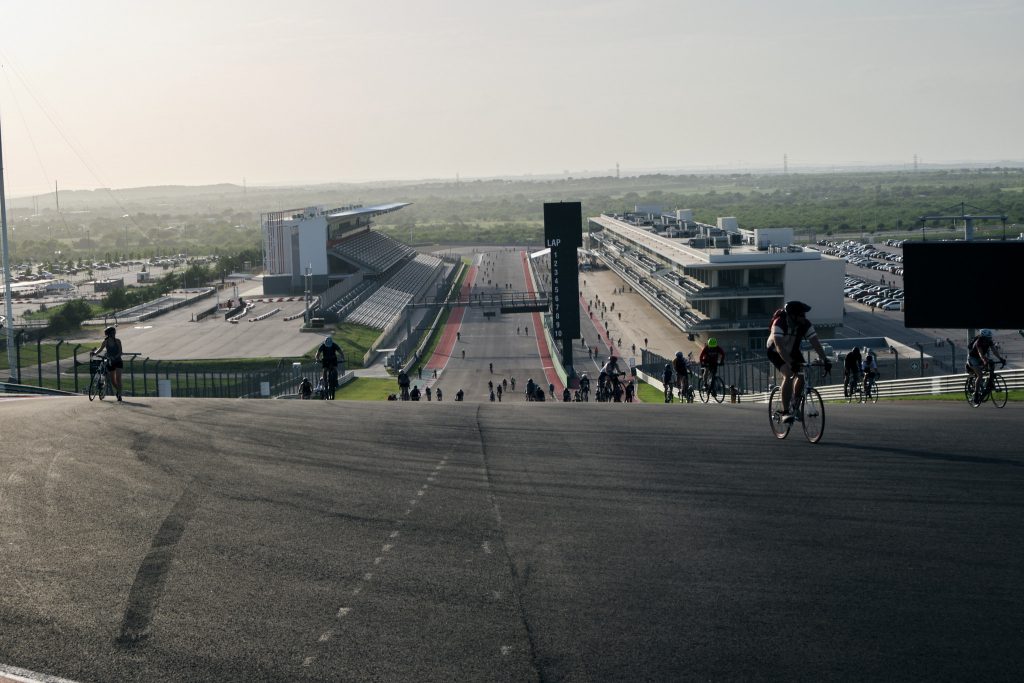
http://circuitoftheamericas.com/bike
The Veloway
The Veloway at Circle C Ranch Metropolitan Park was constructed in the early 90’s and was the first facility of its kind in the United States. The Veloway is a 23’ wide, 3.1 miles (5K) long bicycle tract that traverses the natural terrain. People travel from all over the metropolitan region to cycle here on a daily basis. The project was partially funded by a Texas Parks and Wildlife Grant. (I copy-pasted this)
https://austintexas.gov/department/veloway
Austin Bicycle Map
You’ll likely see this near the checkout in local shops, but it’s also available online.
Here’s the PDF - https://austintexas.gov/sites/default/files/files/COA_bike_map_v12_FULL_web.pdf.
And an interactive version - https://www.arcgis.com/apps/webappviewer/index.html?id=5d0284294f1b41bcad4ea956274a83b3&extent=3084002.7769,10048871.3815,3148002.7769,10081338.0481,102739
The map is well done, and I’ll say that I concur with most of the routes and comfort levels described.
Is Austin a bicycling Mecca? No. Riding here has its problems. There’s the ever-growing sprawl, crazy driving and a striking carelessness about transportation safety. Still, the city has a critical mass of riders that has normalized the sight of cyclists on the road and, as traffic gets worse, many of those who are able are choosing to get around by bike. The site of e-bikes during the morning and evening rush is getting quite common.
What makes riding in Austin great are the people. Take advantage of or get involved in the resources I’ve mentioned here and you’ll quickly find your niche.
Legalize the Idaho Stop Law in Austin
Despite the growth of unchecked sprawl at its periphery as well as the city’s total disregard for safe streets, getting around certain parts of Austin by bike is entirely possible, especially within a four mile radius of downtown. Unfortunately, due to the city’s housing policies, our most bike friendly areas are increasingly becoming the realm of the wealthy (but that’s a discussion for another day). The fact of the matter is that you can easily get around Austin by bike.
Aside from hills and heat, both easily mitigated by fitness, electricity and the simple acceptance that humans sweat, route selection is among the biggest obstacles to riding in the city. And while much of your travel can be conducted on secondary roads, our main thoroughfares still often present the best route from A to B. Roads such as S Lamar, S Congress, 51st, Guadalupe and Ceasar Chavez all regularly see cyclists while also accommodating high volumes of cars occupied by drivers texting, speeding and taking an after-work toke on the drive home (a common smell from vehicles if you regularly ride/walk/run).
How can we vulnerable road users protect ourselves from thousands of mild-mannered office workers who suddenly become murderous, street clogging lawbreakers on their drive home?
One way is the ride defensively: Always assume cars are going to pull in front you, look over your shoulder at approaching cars, make eye contact, take the lane to discourage unsafe passing — there are many techniques. One, however, though legal in the state of its namesake, is quite controversial: The Idaho Stop.
To explain it simply, the Idaho Stop essentially allows cyclists to treat stop signs as yield signs and red lights as stop signs – something many of us already do. The full law can be read here: https://legislature.idaho.gov/statutesrules/idstat/title49/t49ch7/sect49-720/.
What makes the Idaho Stop a defensive technique?
Let’s say we’re heading north on S Lamar on our way to work, and are stopped by the light at Oltorf along with a multitude of giant, singly-occupied metal boxes (adorned with bull bars, of course). Work is just ahead on the left, but transitioning across the lanes among all those sleepy drivers is scary. Oltorf looks clear. What if we just jump ahead of the light while the lanes are empty to safely position ourselves for the left turn, instead of trying to direct a bunch of drivers to “get the eff out of the way and stop trying to kill me as I turn left!”
Or maybe we’re heading home, dutifully ascending S Congress in the bike lane (except when blocked by giant waste-of-space trucks). The light turns red at Gibson. All that momentum, gone! But why sit here? There’s much more climbing to go and Gibson is always empty anyway. Perhaps we’ll just continue our climb with the added benefit of entering the field of view of the many drivers waiting at the light. This lane is, after all, somewhat narrow and unprotected. It’s a justified precaution.
What about stop signs? Well, have you ever traveled S 5th heading toward the city? It’s like two-mile funnel, sending millennials and hippies on commuter bikes into downtown in seven minutes flat. But all those stop signs? Does anybody actually stop? No, they slow down and look both ways, and then continue. Avoiding the loss of momentum and increasing the viability of their chosen mode of transportation. Is this particular example defensive? Not really, but it certainly makes cycling for transportation easier in our ultra spread out city. Consider it “defending your right to ride”.
If you’ve ever driven on Oltorf or S 1st, you know that drivers travel at incredible speeds, hurtling their multi-thousand pound autos through largely residential and pedestrian-trafficked areas. It’s dangerous. I like to think of running stop signs on S 5th as the much safer and saner, yet logically equivalent version of this same act.
What’s more, bikes don’t automatically trigger the lights on cross streets in many areas. Live Oak and S 1st is an example. An individual on a bike should have to push the button just as often as an individual in a car, which is to say “never” (though I’m open to watching drivers have to get out and push the button).
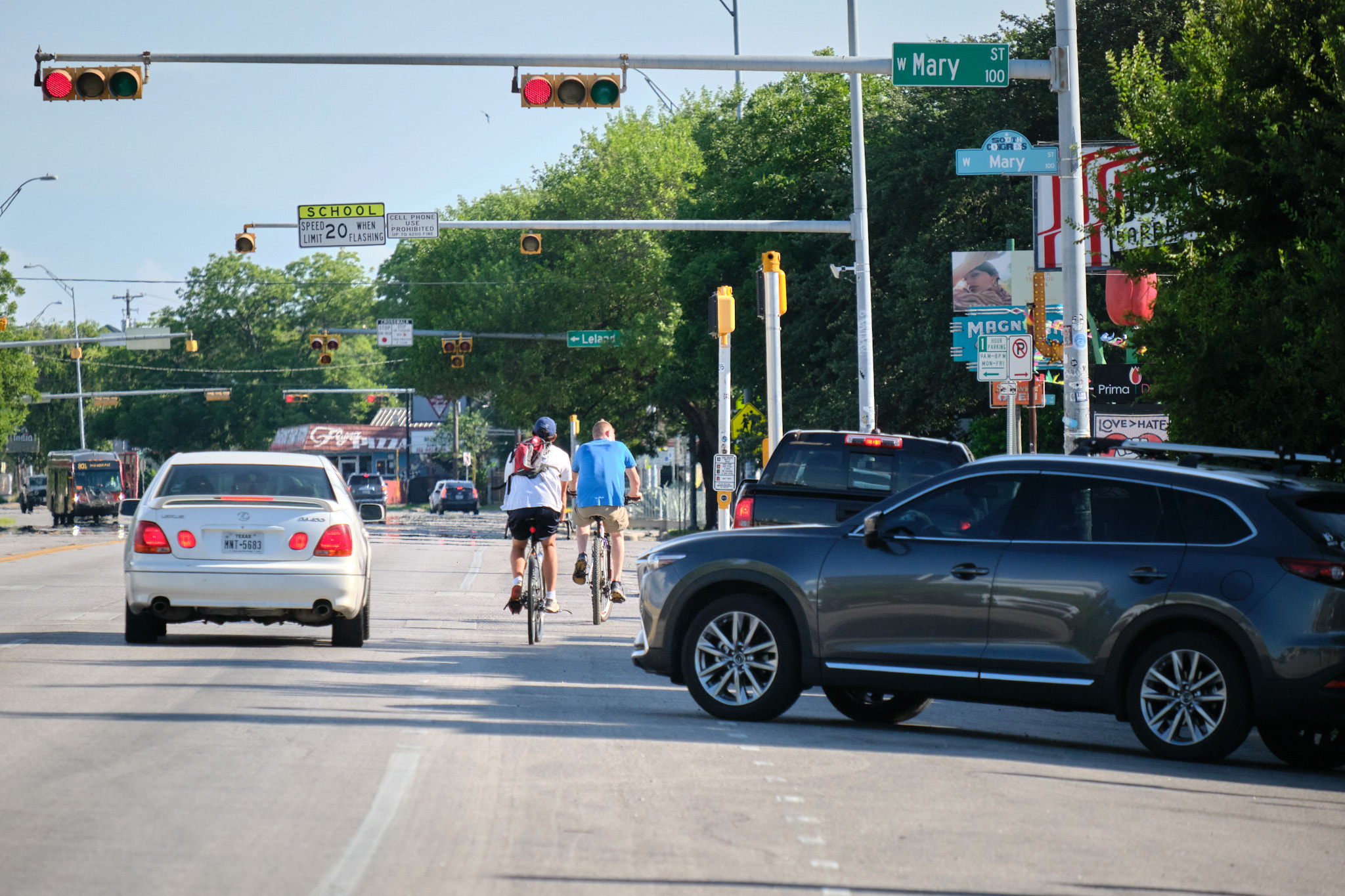
It Isn’t Fair
There’s something about the sight of cyclists eschewing traffic laws that causes ire. I take this as a complement, as it means we cyclists present as human. Note how often automobiles are given agency: “That car got in my way”, “Why is that truck driving so fast?”. Not so with bikes. Imagine referring to another cyclists as a “bike”.
And so it is that, with the cyclist’s humanness on full display, drivers are upset by the sight of seeing a law broken which they themselves are so dutifully following, all while the chaos of traffic swirls around them. “It isn’t fair,” they think, and maybe they’re right.
But is a de facto requirement for car ownership in most parts of the city fair? Is having the entire world paved over for giant, multi-thousand pound wheelchairs at incalculable cost to the livability of our city fair? Is it fair that we build two/three/four lane roads near the edge of town at the drop of a hat for potential newcomers, while safe bike lanes are almost nonexistent and met with forceful resistance?
My arguments are fallacious, of course. The law is the law and fairness has nothing to do with it. Still, a minor act of civil disobedience in exchange for personal safety seems like a good trade. Running a stop sign or crossing against a red light isn’t usually a flippant flouting of the law, but a rational acknowledgment of the unmet needs of cyclists attempting to move through an environment designed for automobiles. Surely, running a red light for safety and efficiency is more noble than driving 20mph over the speed limit on E Riverside while texting, right?
Legalize It
In FY2019, APD wrote 103 traffic tickets for cyclists running red lights and stop signs, down from 158 in 2016. Surely, some of these were the result of unsafe riding, however, darting from the sidewalk into the road or bombing through a red light isn’t the same thing as a vehicular cyclist yielding and then continuing at a stop sign or, after waiting, riding against the red through a clear intersection.
Though the heat can sometimes be intense, Austin weather is a dream for getting around by bike. In choosing to ride, a cyclist is doing the city a service by getting one less car off Austin’s overflowing streets and helping to decrease demand for expensive and inefficient automobile infrastructure, including the massive amount of parking that takes up so much of our city.
Let’s return the favor. Rather than punishing cyclists for doing what we know they’re going to do and upholding the cyclist-as-lawbreaker ethos, the city should declare its support for a mode of transportation with no downsides, and become a role model for forward thinking urban transportation policy in the United States.
Bike for Your Country
Yes, for your country. While patriotic flags and sayings may often adorn large SUVs driven by soccer moms and suburban cowboys, it doesn’t take much effort to slap a flag sticker on your truck. Those who truly want to display their patriotism through mobility choose a mode of transportation quite the opposite from a world-burning Dodgy Ram.
The fact of the matter is that, flag-bearing or not, these vehicles take up an immense amount of space, not only in their immediate footprint or while idly parked (where they live 95% of the time), but also in the required road network, parking and general auto-centric development pattern needed for their utilization - a system that comes at a huge price to American citizens, both in direct costs and, also, indirectly in the form of lost productivity, excessive land use, inefficiency and the displacement of those who can’t afford to live close to where they work.
After 70 years of developing our cities for automobiles rather than humans, the average citizen has become somewhat “car blind”. Still, the case remains that alternatives exist. These alternatives are more efficient, cheaper, more “free market”, and better for the environment, yet the automobile remains “the answer” to most citizens, who know nothing else and, understandably, hardly have time to think about much more than making ends meet, let alone reading about transportation issues in their free time.
“Free market? Forcing bike lanes and trains down my throat isn’t free market,” you might say. This is understandable. Years of market-distorting laws favoring automobile transportation are what got us here, such as parking minimums, single-family residential zoning, square footage minimums, development requirements for wide, high speed roads - the list goes on. What’s resulted is a cycle of auto dependency where alternatives to automobile transportation have become impossible, with endless federal funds in the form of what amounts to payday loans to keep the auto-centric development churning. With unchecked state and federal road infrastructure funding , there’s no incentive to stop building cities outward into expensive non-places full of big box stores and cookie cutter snout-house subdivisions - places inhospitable humans not encased safely SUVs.
That’s where bikes come in. Your town, city, municipality, or village may not have acceptable transit service, everything is too spread out to walk, Uber-ing everywhere is prohibitively expensive, and autonomous vehicles are still a Silicon Valley fantasy. The bicycle, however, in all its high-efficiency glory, can move a human just far enough, just fast enough, to get them where they’re going without having to drive. No, if you live in the country and have to take Farm to Market 920 (i.e., Sprawl to Parking 920) fifteen miles to the grocery store, bicycling probably won’t work for you. If, however, you’re anyone from a small town dweller, up to and including a city slicker who has amenities within a reasonable distance of home - you can absolutely ride your bike for transportation.
Below is a picture of my “car”. Within a reasonable radius of my apartment, I run any errand I please without a second thought. Too hot? Humans sweat. Too cold? I’ll warm up with a little movement. Rain? Where I live, it doesn’t rain continuously, but I save enough not owning a car to justify buying some pretty awesome rain gear (or to be chauffeured to my destination in an Uber on special occasions).
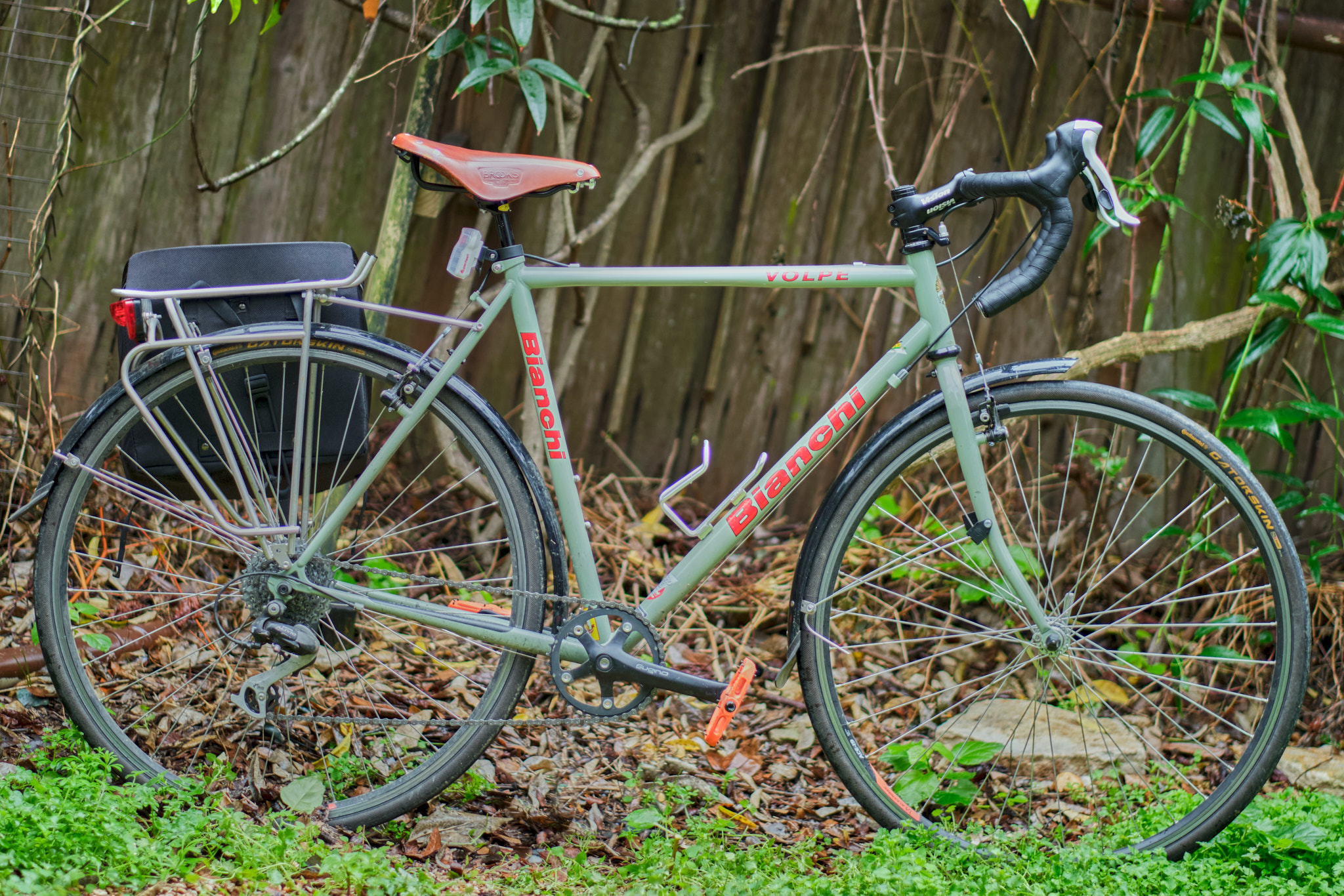
My area isn’t dense. Houses have yards, there are ugly parking lots and soulless big box stores, nonetheless, everything I need is close enough to reach by bike and I’m fortunate enough to have relatively safe streets on which to make these trips.
The most striking thing about my trips is how much I’m slowed down by automobile infrastructure. In most cases, I can reach my destination in less time than it takes to drive (especially during rush hour) utilizing sidewalks, trails and the “Idaho Stop” (civil disobedience, right?). Single-family housing, parking and excessive, land-wasting roads take up most of the space between points A and B. I, and every cyclists I see along the way, however, require very little space. This image does a good job of illustrating that:
Every additional cyclist on the road highlights the absurdity of the development patterns we have in place. Designing for this:
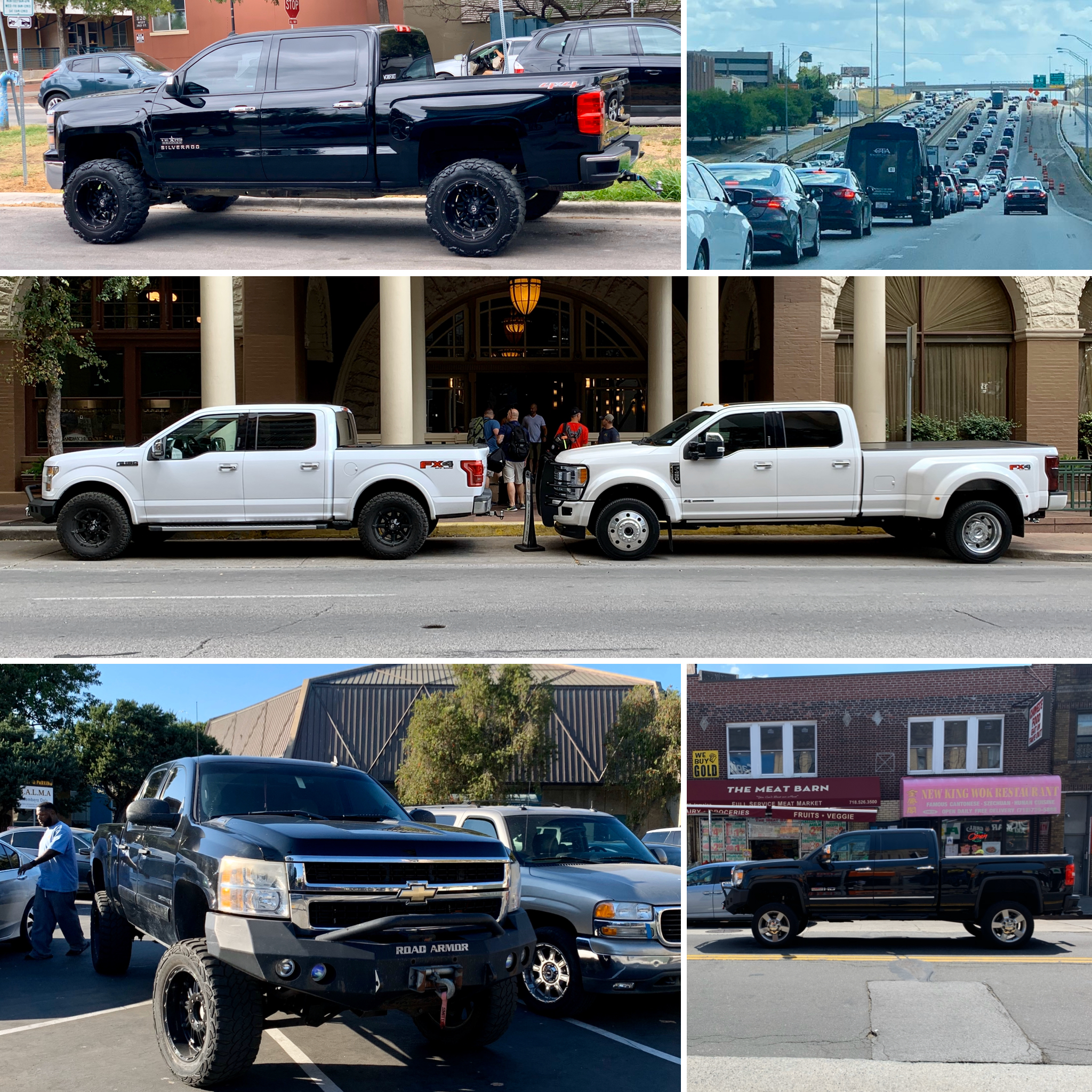
Creates this:

The above, in case you don’t recognize the reference, is an auto-centric non-place with an incredible infrastructure burden relative to its density. The generation who built this won’t be around to endure the incredible cost of its maintenance, which will either be funded through high federal/state taxes or crushing millages/assessments on the individual citizens who live here. “Freedom” to live where one desires is often brought into the conversation when sprawl and single-family housing is criticized, however, there’s nothing “free” about burdening fellow citizens with the cost of such development, or demanding that every public space be destroyed for the sake of one’s giant metal wheelchair, or a de facto car ownership requirement. By all means, choose live where you want, but let’s reconfigure the market so that true costs are reflected in those choices. Declaring the area pictured above as “freedom” is similar to one demanding that they be free to live in subsidized housing or to receive welfare.
Will glimpsing the occasional cyclist change anyone’s mind about driving or housing? Probably not immediately, but when citizens demonstrate that they can get from place to place without wrapping themselves in a 6,000 pound wheelchair and show their city that they want the ability to do so, change happens. More cyclists means more bike lanes, more awareness from drivers, more density and less parking. The most able bodied among us, especially, who want to see change, have a responsibility to get out there and ride, as it’s often the case that, while a person of stout age and fitness can make their way reasonably well through city streets, these streets aren’t yet safe enough for children, families or the elderly.
Choosing cycling (or walking, or transit, etc.) over driving is one small vote for human-scale cities and towns, for fiscally responsible and sustainable development patterns, for safe streets that value life over vehicles per hour, for mobility over isolation.
Cities are man’s greatest invention. The sprawling, auto-centric development patterns we’ve come to normalize in this post-war era are chipping away at our cities little by little. When you see someone riding their bike as a means of transportation in America, whether by necessity or choice, consider it the exemplar of all those little SUV window flags in action. Bike for your country.
